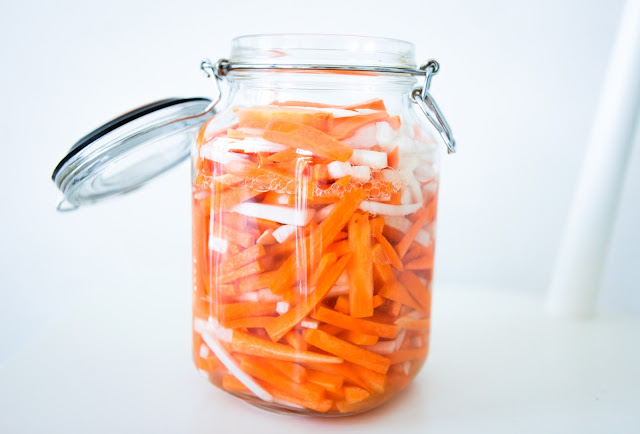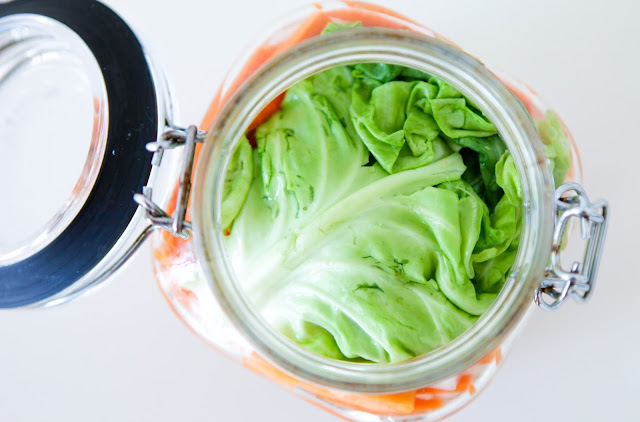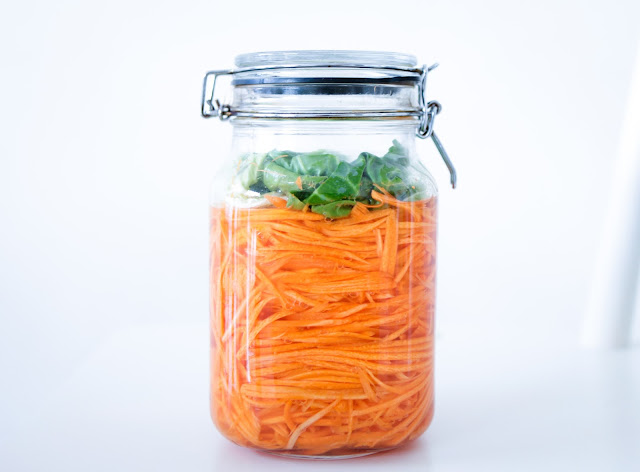
Vietnamese Pickled Carrots (Đồ Chua) – Naturally Fermented
Growing up in my mum’s house there were always jars of pickled carrot, daikon radish, cauliflower, lemons and cumquats sitting around. My mum used sugar, salt and allowed them to sit and create their own brine. I absolutely loved the sweet and sour crunch the vegetables added to all our dishes. We made iced fermented lemon and cumquat drinks during the summer which were sweet, salty and sour all at the same time. I wanted to trial making an in between version of my mum’s traditional Vietnamese carrots which uses sugar with my salt brine. Leaving the vegetables to ferment long enough should allow the sugars to be consumed by the beneficial bacteria resulting in a less sour but crunchy and tangy ferment. Turned out so good, I got my mum’s approval for this recipe! (it is not any where nearly as sweet as her original version and the longer you leave it, the less sugar there is).
 |
| Vietnamese Pickled Carrots (Đồ Chua) – Naturally Fermented |
Fermented vegetables are also known as lacto-fermented vegetables. Lacto refers to the family of good bacteria mainly lactobacillus (not related to dairy, although they were first studied in dairy ferments hence the name). This family of bacteria converts sugars to lactic acid which inhibits the growth of bad bacteria. In addition it also increases and preserves the vitamin content of the vegetables as well as enabling easier digestion of the vegetables opposed to eating them raw.
Most commercial methods to make Vietnamese Pickles use vinegar to give the sour taste, my mum also started pickling her veggies this way too as it is quicker but you do not get the probiotic benefits using vinegar. The fermentation process will naturally give you the sour taste so it’s worth sticking to this traditional method to get the most nutritional value and benefit.
Here are some tips for successful vegetable fermentation and how to get your children to eat fermented vegetables:
A few easy signs to tell your ferment is going well is looking at the colour of the vegetables, lacto-fermentation is a traditional method used my many cultures to preserve vegetables. The colour of your vegetables should be bright and vibrant. You will see bubbles appear and may hear some hissing and spluttering of liquids and gasses escaping. All good signs that the fermentation process is going well.
Storage:
You can leave your fermented vegetables on the counter for at least 6 months, I have had mine sitting on the counter for a year and they were still crunchy and tasty. There is absolutely no need to refrigerate after the fermentation period of 7 to 30 days. Lacto-fermentation is a method of preservation, so refrigeration is not needed until you open the jar. Refrigeration also slows down the fermentation process which you don’t really want when you are fermenting foods.
Vietnamese Pickled Carrots (Đồ Chua) – Naturally Fermented
Store: on the counter, refrigerate only once opened.
- 1 x 1.5 litre (1.5 quart) flip top lid glass jar
- 350 gms (12 oz) each of carrot and daikon or 1kg carrots for shredded carrots
- 1.5 tbsp (22 gms / 0.77 oz) good quality sea salt (buy on iherb or amazon)
- Optional tbsp starter culture (reduce the salt to 1 tbsp) (buy here or here in AU use discount code ‘loveurbelly’)
- 2 tbsp (30 gms / 1 oz) raw organic sugar (buy on iherb or amazon) (after 2 weeks of fermentation, most if not all the sugar has been consumed by the bacteria and the carrots are not sweet at all)
- filtered water
- 2 large outer cabbage leaves
- Wash your glass jar with hot water and distilled (white) vinegar (do not use soap or your kitchen sponge)
- Set aside to air dry while you prepare your vegetables
- Peel and chop your vegetables or using a julienne peeler shred the carrots (do not use a food processor or box grater, you will not get the right texture for Vietnamese pickles, a mandolin would work)
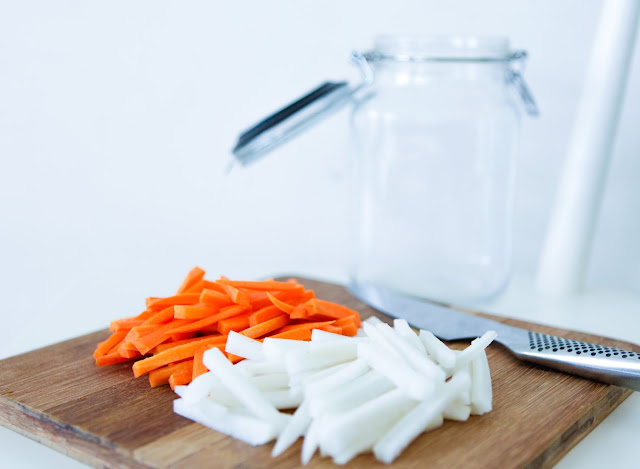 |
| If making the carrot & daikon, slice the carrot and daikon radish into small sticks |
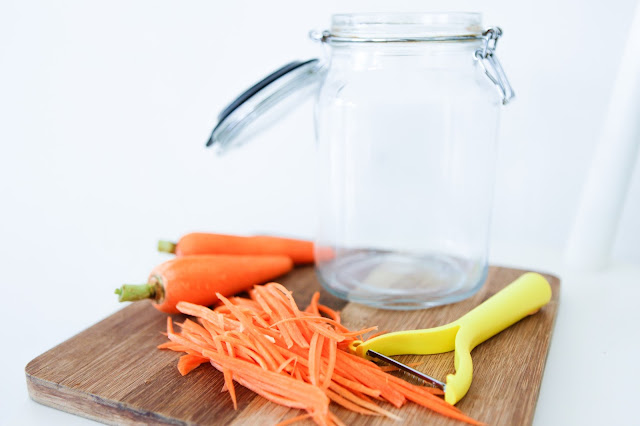 |
| If making the shredded carrots use a mandolin or julienne peeler (not grater or food processor as thetexture is important for this ferment) |
- Place the vegetables in a large mixing bowl and add the salt and sugar
- Massage for approximately 10 minutes to dissolve the salt and sugar and bring out some of the liquids from the vegetables
- If time allows, set aside for an hour to allow more liquids to accumulate
- Add vegetables to the jar including any juices and push down as much as you can, ensure there is at least a 2 inch gap from the top to avoid leakage and spillage
- Add in enough filtered water to just cover the vegetables once pushed down and compacted
- Roll up the 2 outer cabbage leaves and push the vegetables down, this should bring the water level up to the top, more liquid will be produced from the vegetables over the next few days
- Leave for at least 7 days (I usually do 14 days)
- 1 x 1.5 litre (1.5 quart) flip top lid glass jar
- 350 gms (12 oz) each of carrot and daikon or 1kg carrots for shredded carrots
- 1.5 tbsp (22 gms / 0.77 oz) good quality sea salt (buy on iherb or amazon)
- Optional tbsp starter culture (reduce the salt to 1 tbsp) (buy here or here in AU use discount code 'loveurbelly')
- 2 tbsp (30 gms / 1 oz) raw organic sugar (buy on iherb or amazon) (after 2 weeks of fermentation, most if not all the sugar has been consumed by the bacteria and the carrots are not sweet at all)
- filtered water
- 2 large outer cabbage leaves
- Wash your glass jar with hot water and distilled (white) vinegar (do not use soap or your kitchen sponge)
- Set aside to air dry while you prepare your vegetables
- Peel and chop your vegetables or using a julienne peeler shred the carrots (do not use a food processor or box grater, you will not get the right texture for Vietnamese pickles, a mandolin would work)
- Place the vegetables in a large mixing bowl and add the salt and sugar
- Massage for approximately 10 minutes to dissolve the salt and sugar and bring out some of the liquids from the vegetables
- If time allows, set aside for an hour to allow more liquids to accumulate
- Add vegetables to the jar including any juices and push down as much as you can, ensure there is at least a 2 inch gap from the top to avoid leakage and spillage
- Add in enough filtered water to just cover the vegetables once pushed down and compacted
- Roll up the 2 outer cabbage leaves and push the vegetables down, this should bring the water level up to the top, more liquid will be produced from the vegetables over the next few days
- Leave for at least 7 days (I usually do 14 days)


